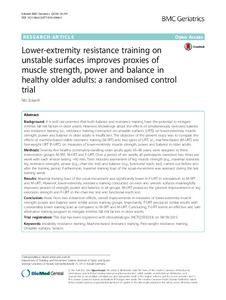| dc.date.accessioned | 2017-06-26T10:18:59Z | |
| dc.date.available | 2017-06-26T10:18:59Z | |
| dc.date.issued | 2016-11-24 | |
| dc.identifier.issn | 1471-2318 | |
| dc.identifier.uri | urn:nbn:de:hebis:34-2017062652719 | |
| dc.identifier.uri | http://hdl.handle.net/123456789/2017062652719 | |
| dc.description.sponsorship | Gefördert durch den Publikationsfonds der Universität Kassel | |
| dc.language.iso | eng | |
| dc.rights | Urheberrechtlich geschützt | |
| dc.rights.uri | https://rightsstatements.org/page/InC/1.0/ | |
| dc.subject | Instability resistance training | eng |
| dc.subject | Machine-based resistance training | eng |
| dc.subject | Free-weight resistance training | eng |
| dc.subject | Unstable surfaces | eng |
| dc.subject | Seniors | eng |
| dc.subject.ddc | 796 | |
| dc.title | Lower-extremity resistance training on unstable surfaces improves proxies of muscle strength, power and balance in healthy older adults: a randomised control trial | eng |
| dc.type | Aufsatz | |
| dcterms.abstract | Background:
It is well documented that both balance and resistance training have the potential to mitigate intrinsic fall risk factors in older adults. However, knowledge about the effects of simultaneously executed balance and resistance training (i.e., resistance training conducted on unstable surfaces [URT]) on lower-extremity muscle strength, power and balance in older adults is insufficient. The objective of the present study was to compare the effects of machine-based stable resistance training (M-SRT) and two types of URT, i.e., machine-based (M-URT) and free-weight URT (F-URT), on measures of lower-extremity muscle strength, power and balance in older adults.
Methods:
Seventy-five healthy community-dwelling older adults aged 65–80 years, were assigned to three intervention groups: M-SRT, M-URT and F-URT. Over a period of ten weeks, all participants exercised two times per week with each session lasting ~60 min. Tests included assessment of leg muscle strength (e.g., maximal isometric leg extension strength), power (e.g., chair rise test) and balance (e.g., functional reach test), carried out before and after the training period. Furthermore, maximal training load of the squat-movement was assessed during the last training week.
Results:
Maximal training load of the squat-movement was significantly lower in F-URT in comparison to M-SRT and M-URT. However, lower-extremity resistance training conducted on even and uneven surfaces meaningfully improved proxies of strength, power and balance in all groups. M-URT produced the greatest improvements in leg extension strength and F-URT in the chair rise test and functional reach test.
Conclusion:
Aside from two interaction effects, overall improvements in measures of lower-extremity muscle strength, power and balance were similar across training groups. Importantly, F-URT produced similar results with considerably lower training load as compared to M-SRT and M-URT. Concluding, F-URT seems an effective and safe alternative training program to mitigate intrinsic fall risk factors in older adults. | ger |
| dcterms.accessRights | open access | |
| dcterms.bibliographicCitation | In: BMC Geriatrics. - London : BioMed Central. - (2016) 16:191 | |
| dcterms.creator | Eckardt, Nils | |
| dc.relation.doi | doi:10.1186/s12877-016-0366-3 | |

